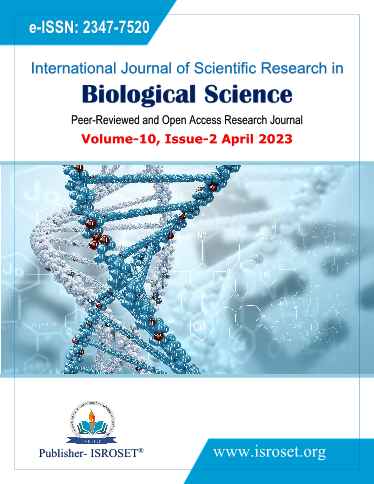Wading Birds in Lacustrine Wetland of Shrungarbandh Lake, District Gondia, Maharashtra
Keywords:
Wading birds, Shrungarbandh Lake, Lacustrine water,, Wetland, ConservationAbstract
This Shrungarbandh Lake becomes increasingly productive as nutrients from the neighboring watershed collect in the form of compost, sediments, and other items. The Lake provides as an ideal wetland habitat for a variety of wading birds due to organic materials` enrichment that stimulate the growth of aquatic weeds, algae micro zooplanktons. By keeping a record of wading birds as per IUCN as well as Residential status, the present work of this wetland contributes in the protection and restoration of the existing condition of the wetland. The purpose of this study is to illustrate the state of wading bird biodiversity so that this habitat may be designated as a significant habitat for bird conservation. Anthropogenic activities have been shown to have an influence on this ecosystem. Wader tracking is a valuable method for emphasizing the significance of wetlands and its ecological values since it provides essential information on the condition of wetlands. From 2019 to 2021, a wading bird research was carried out in Shrungarbandh Lake. 16 families of wading birds recorded a total of 79 species. In the current findings, the birds were categorized using the IUCN Red Data Book for 2022, 07 species were identified as near threatened (NT), with the number of species decreasing (D). While 03 species were identified as vulnerable, their numbers were determined to be decreasing (D). Out of a total of 79 wading birds, 44 are determined to be residential, while 44 are winter migrants. The findings of this observations show that the avifauna in this area is plentiful, indicating the wetland is in good condition. The abundance is owing to the plenty of protein-rich invertebrates and other food, as well as safe environment. Long-distance migrants utilize the lake as a feeding area, while local migrants use it as a nesting site. Nesting colonies of grey herons, as well as other local migrants including cormorants, large egrets, and others, found here.
References
David Dudgeon, Angela H. Arthington, Mark O. Gessner, Zen-Ichiro Kawabata, Duncan J. Knowler, Christian Le´veˆque, Robert J. Naiman, Anne-He´le`ne Prieur-Richard, Doris Soto, Melanie L. J. Stiassny and Caroline A. Sullivan “Freshwater biodiversity: Importance, threats, status and conservation challenges”. Biological Reviews, 81, 163-182, 2006.
J.B. Zedler, S. Kercher, “Wetland Resources: Status, Trends, Ecosystem Services, and Restorability”. Annu. Rev. Environ. Resour. 30:39–74. 2005.
R. Grimmett, C. Inskipp, T. Inskipp, “Birds of the Indian Subcontinent”. 2nd ed. London: Oxford University Press & Christopher Helm. Pp. 1–528, 2011.
R. Manakadan, A. Pittie, “Standardized common and scientific names of the birds of the Indian subcontinent”. Buceros 6(1):1-37, 2001.
A.Kumar, J. P. Sati, P. C. Tak, J. R. B. Alfred, “Handbook on Indian wetland birds and their conservation”. Zoological Survey of India, Kolkata, 472 p, 2005.
P. Kumar, S.K. Gupta, “Diversity and Abundance of Wetland Birds around Kurukshetra, India”. Our Nature, 7:212-217, 2009.
A. Kumar, J.P. Sati, P.C. Tak, “Checklist of Indian Waterbirds”. Buceros. 8 (1): 30, 2003.
P. N. Dayawansa, M. R. Wuesinghe. “Waders in Sri lanka A guide to their identification and study”. National Science Foundation, ISBN 955-590-035-3.2002
R. J. Safran, C.R. Isola, M.A. Colwell O. E. Williams, “Benthic invertibrates at foreaging locations of nine watervirsd species in managed wetlands of northern San Joaquin valley, California”, Wetlands 17, 407-415. 1997.
M. Karthikeyan, “Avifauna and their habitat utilization in three different habitats of Parambikulam Wildlife Sanctuary”. Ph.D. thesis submitted to School of Environmental Sciences, Mahatma Gandhi University, Kottayam, Kerala. 2007.
G. H. Kattan, P. Franco, “Bird diversity along elevational gradients in the Andes of Colombia: area and mass effects”. Global Ecology & Biogeography, 13:451-458, 2004.
G.T. Paliwal, S.V. Bhandarkar, W. R. Bhandarkar, “Insecticides Killing the threatened Sarus Crane in Eastern Vidarbha, Maharashtra: A case study”. Indian Stream Research Journal, Special issue: pp.15-18, 2013.
S.V. Bhandarkar, R.N. Chavan, “Observation on the avifaunal diversity in and around Shringarbandh Lake, Bondgaon (Surban), district Gondia, Maharashtra”. J. Curr. Sci. 12(2): 573-576, 2008.
S.V. Bhandarkar, G.T. Paliwal, “Biodiversity and conservation status ofwater birds in Shrungarbandh lake district Gondia Maharashtra, India”, Int. J. of Life Sciences, 2(3): 239-243. 2014.
S. Ali, “The Book of Indian Birds”. 13th revised edition. Bombay Natural History Society, Bombay, 326, 2002.
R. Grimmett, T. Inskipp, “Birds of Southern India”. Om Books International, New Delhi, India. 2007.
A. Froneman, M.J. Mangnall, R.M. Little, T.M. Crowe, “Waterbird assemblages and associated habitat characteristics of farm ponds in the Western Cape, South Africa”. Biodivers Conserv 10:251– 270, 2001. doi:10.1023/A:1008904421948
IUCN, “The IUCN Red List of Threatened Species”. Version 2021-3., 2022. https://www.iucnredlist.org
V. S. Vijayan, “On conserving the bird-fauna of Indian wetlands” In: Proceeding of Indian Academy of sciences (Suppl.): 91-101, 1986.
G.T. Kedar, G.P. Patil, “Avifaunal diversity of Rishi Lake, Karanja (Lad) Maharashtra with reference to food preference and feeding habits”. J. Aqua Biol. 20:35-38, 2005.
P. S. Joshi, “An annotated checklist of aquatic avifauna of Rajura, Godada and Dhanora lakes of Buldhana district of (MS) India”. Science Research Reporter 2(1):30-33, 2012.
M. Paracuellos, “How can habitat selection affect the use of a wetland complex by waterbirds?” Biodiversity and Conservation, 15: 4569-4582. 2006.
T. Siva, P. Neelanarayanan, “Avifauna checklist of Karaivetti Bird Sanctuary in Ariyalur District, Tamil Nadu”. Sarovar Saurabh ENVIS Newsletter. 13 (2) pp 1-5, 2017.
G. A. Wagh, N. Jane, J. S. Wadatkar, A. S. Rawankar, “Waders Diversity of Wetlands in Amravati region, Maharashtra”. Proc UGC Sponsored National Seminar on Wetland-Present Status, Ecology & Conservation ISBN: 978-81-925005-3-9: 26-32, 2015.
Downloads
Published
How to Cite
Issue
Section
License

This work is licensed under a Creative Commons Attribution 4.0 International License.
Authors contributing to this journal agree to publish their articles under the Creative Commons Attribution 4.0 International License, allowing third parties to share their work (copy, distribute, transmit) and to adapt it, under the condition that the authors are given credit and that in the event of reuse or distribution, the terms of this license are made clear.







